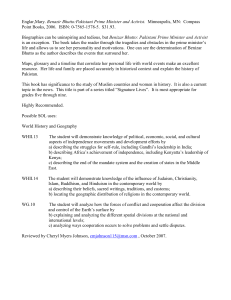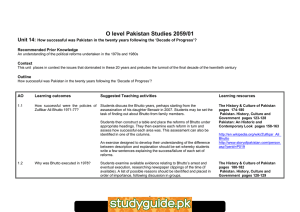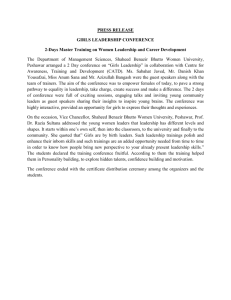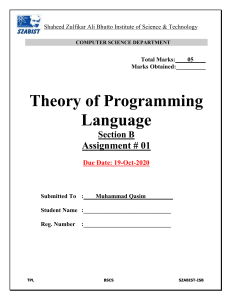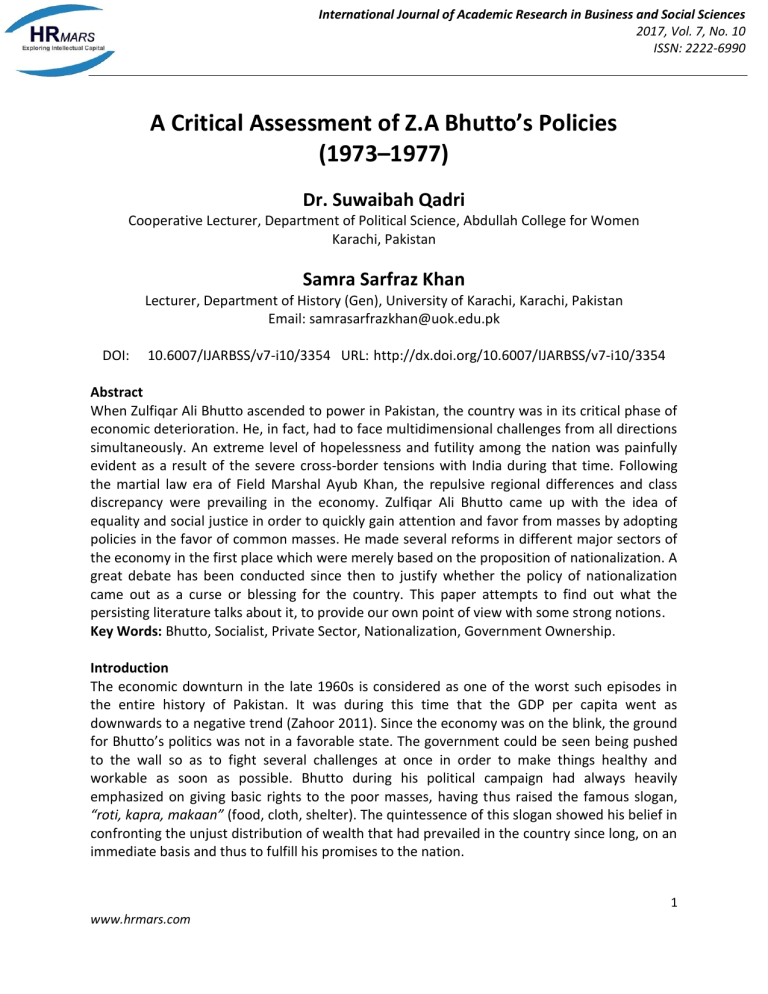
International Journal of Academic Research in Business and Social Sciences 2017, Vol. 7, No. 10 ISSN: 2222-6990 A Critical Assessment of Z.A Bhutto’s Policies (1973–1977) Dr. Suwaibah Qadri Cooperative Lecturer, Department of Political Science, Abdullah College for Women Karachi, Pakistan Samra Sarfraz Khan Lecturer, Department of History (Gen), University of Karachi, Karachi, Pakistan Email: samrasarfrazkhan@uok.edu.pk DOI: 10.6007/IJARBSS/v7-i10/3354 URL: http://dx.doi.org/10.6007/IJARBSS/v7-i10/3354 Abstract When Zulfiqar Ali Bhutto ascended to power in Pakistan, the country was in its critical phase of economic deterioration. He, in fact, had to face multidimensional challenges from all directions simultaneously. An extreme level of hopelessness and futility among the nation was painfully evident as a result of the severe cross-border tensions with India during that time. Following the martial law era of Field Marshal Ayub Khan, the repulsive regional differences and class discrepancy were prevailing in the economy. Zulfiqar Ali Bhutto came up with the idea of equality and social justice in order to quickly gain attention and favor from masses by adopting policies in the favor of common masses. He made several reforms in different major sectors of the economy in the first place which were merely based on the proposition of nationalization. A great debate has been conducted since then to justify whether the policy of nationalization came out as a curse or blessing for the country. This paper attempts to find out what the persisting literature talks about it, to provide our own point of view with some strong notions. Key Words: Bhutto, Socialist, Private Sector, Nationalization, Government Ownership. Introduction The economic downturn in the late 1960s is considered as one of the worst such episodes in the entire history of Pakistan. It was during this time that the GDP per capita went as downwards to a negative trend (Zahoor 2011). Since the economy was on the blink, the ground for Bhutto’s politics was not in a favorable state. The government could be seen being pushed to the wall so as to fight several challenges at once in order to make things healthy and workable as soon as possible. Bhutto during his political campaign had always heavily emphasized on giving basic rights to the poor masses, having thus raised the famous slogan, “roti, kapra, makaan” (food, cloth, shelter). The quintessence of this slogan showed his belief in confronting the unjust distribution of wealth that had prevailed in the country since long, on an immediate basis and thus to fulfill his promises to the nation. 1 www.hrmars.com International Journal of Academic Research in Business and Social Sciences 2017, Vol. 7, No. 10 ISSN: 2222-6990 The policies that Bhutto adopted were primarily based on the ideas and principles of socialism. The document of Pakistan People’s Party’s (PPP) manifesto issued for 1970 began with the words “Islam is our faith. Democracy is our policy. Socialism is our economy. All power to the people”. To implement the socialist economic setup, Bhutto’s Government nationalized the various firms that had been practicing in a private capacity so far. No private ownership was promoted as socialist setup encouraged the accumulation of all available national wealth in the favor of public ownership. Bhutto also introduced massive reforms in various sectors of the economy in order to bring revolutionary changes in a short span of time. Whether those reforms and policies favored the progress of the country or came out as another obstacle, however, still remains a topic for serious debate. Bhutto’s government is often accredited of initiating such policies that encouraged the promotion of education, science and technology. For example, in order to empower the health sector of the country, it can be observed that several medical colleges and institutions were established during Bhutto’s regime. This initiative contributed greatly in encouraging the number of pupils choosing medicine as their subject (Yousuf and Hamid 1980). It was also during this time that doctors were now formally instructed to write a proper medical prescription for the patients (Raza 2012). In contrast to this new method, patients before this time were only given medicines in exchange of the fee charged by doctors. This outdated practice was banned for the first time during Bhutto’s era and a proper and official prescription became a compulsion to be followed by the every medical personnel operating in the country. Similarly, the reforms introduced in the national education system during Z.A Bhutto’s regime have their own significance in the history of Pakistan. Educational institutions throughout the state, including schools and colleges, were nationalized (Haq 2013). A grant commission to provide monetary aid to universities and higher education institutes was also formed during this time. The responsibility of the commission was to facilitate the institutes of higher education and universities by issuing in their favor all the necessary funds required for the development in all relevant fields (Mahmood and Rauf 2008). In order to encourage basic education for the people of the country, the schools were encouraged to offer free of cost education. For the same purpose, a foundation under the title of National Book Foundation was established to assure uniformity in curriculum of the national educational institutions (Raza 2012). The reforms initiated by Bhutto in the fields of health and education were highly significant and have since remained a matter of debate; receiving both applaud as well as criticism. Nevertheless, the most crucial set of reforms that were introduced during Bhutto’s term in office were those that were particularly directed for the industrial sector. These reforms were highly crucial initiatives as with these reforms he undertook the most daring step of nationalizing the industries and placing them under charge of the government. Undertaken with the expectation of stabilizing the economic profile of the country, this policy rather discouraged the business sector on a massive level. Of all the industries operational in the country, only those industries that had been established through foreign investment were allowed to practice privately while all the other industries were given under government ownership. (Rehman and Rauf 2006). Banks and insurance companies that had heretofore been 2 www.hrmars.com International Journal of Academic Research in Business and Social Sciences 2017, Vol. 7, No. 10 ISSN: 2222-6990 practicing on a private level; were also nationalized under the auspices of Bhutto’s nationalization venture of the time (Panhwar, 2009). Establishment of State Life Insurance Corporation occurred as in to improve economy of the country (Raza 2012). Agriculture sector, which has forever remained the most important constituent of Pakistan’s economy, also underwent various reforms. The government devised a policy under which limit was corked upon land ownership. The limit to own canal land was fixed between 150 and 500 acre while 300 to 1000 acre rainy land was allowed to be owned by the orders of the central government (Haq 2013). The unclaimed land was distributed among those farmers and cultivators who lacked ownership of agricultural land. However, the part of the land lying close to defense lines was seized by the government (Haq 2013). While large scale nationalization was being carried out across the state, at the same time, the government also announced the allocation of 100 acre land on retirement of high ranking government officials (Raza 2012). The land given to farmers and cultivators by government was transferred in their names and they held the legitimate right to retain or trade that land (Haq 2013). The land owners were however obliged to provide seed to the cultivator (Panhwar, 2009). In 1977, the ownership of agricultural land was further limited and finally shrunk to the fixed limit of 100 acre canal land while 150 acre of the rainy land so far. In view of the marginal size of properties available to many of the farmers, in the same year, those who owned less than 12 acre of land were exempted from paying any taxes (Panhwar 2009). Since the government centred on the guidelines of roti, kapra, makan, the government of Z.A Bhutto was also the first in history to particularly cater to the needs of the labor class. The first such scheme could be seen in the fact that the system of giving labors a proper monthly salary was also formulated in Bhutto’s regime. Moreover, Bhutto encouraged granting bonus to labors; a practice that had lacked a committed patronage at socio-political level in the past. Of the other major steps that were taken to encourage the productivity of labor included the provision of social security to the working class. The government of Bhutto also announced the grant of rupees five hundred so as to bear expenses of funeral and burial formalities in the case of labor’s death. The residential quarters were also announced to be allotted among the labors of the economy (Haq 2013). The inception of these measures, old as they were to the developed states of the time, were highly unfamiliar and greatly non-conventional in Pakistan. As a result, the policies attracted both criticism as well as appreciation from all circles of the society. Taking an overview of the policies initiated in various sectors of the state during Bhutto’s term in office, it can be abridged to the fact that his policies were mainly based merely on the principles of socialism which left no room for private ownership of property. Other than a few exceptions, Bhutto’s government largely nationalized not only the industrial sector but also other state institutions. In regards to the theory whether the policies of Z.A Bhutto resulted in a fruitful or below par production of the various state sectors, different scholars and researchers have held varying point of views about the reforms introduced during his era. A concise review based on the existing literature relevant to the study of Bhutto’s reforms is necessary before giving a personal analysis regarding this subject. 3 www.hrmars.com International Journal of Academic Research in Business and Social Sciences 2017, Vol. 7, No. 10 ISSN: 2222-6990 Method (Literature Review) To understand the policies, reforms and their effects on the Pakistani sociopolitical and economic landscape, an in depth study of literary sources dealing with the study of the policies and practices of Z.A Bhutto in indispensible. For this purpose, a comprehensive and detailed review of some of the most notable available literature has been conducted and is discussed below. It is has often been debated on a grand level as to what factors were responsible for shaping the policies of PPP in general and of Z.Z Bhutto in general towards a socialist and ultra nationalist trend. A particular opinion in this regard considers the importance that Bhutto conferred to China as mainly responsible for the development of socialist tendencies in Bhutto’s policies. According to this view, in order to develop closer ties with Beijing, which by this time was a practicing socialist state, it was important for Bhutto to shape the national policies in such a way so as to bring Pakistan on the same socialist page with its neighbor. The manifesto of PPP itself quotes the four basic principles which shaped Bhutto’s political organization. These were; Islam as faith, democracy as the policy, socialism as the guiding principle of national economy and allocating power to the people of the country. These principles were immediately put into practice with positive results in short span of time (Panhwar 1970). Another source of literature regarding Bhutto’s regime is of the opinion that the Bhutto’s policies had a vital significance in the country’s history because it redefined the issues and put forward some novel methods to deal with economic and foreign issues of such gravity (Kiran 2015). It is also argued that Bhutto’s economic policy is an amalgamation of both Socialism and Islamization. It is believed that the policies of Bhutto were not solely based on pure socialist principles of any nation’s economic structure but rather had some notions of Islamic ideology as well (Taha 2012). The Constitution of 1973, the biggest and most widely lauded contribution of Bhutto’s era, is quoted by scholars sharing this opinion. On the other hand, there are also certain scholars who rather believe that the constitution of 1973, designed by Bhutto was heavily compromising on some important Islamic rights that could have not so very well pleased the leftist elements in the parliament. He also thinks that the constitution of 1973 provokes a notion regarding the existence of new socio-economic orientation that reflects social progressivism and justice (Rehman 1973). Since, the industrial policy of any state is the most decisive policy and has always been looked upon as the actual challenge for a government (Haq 2015), Bhutto therefore took a giant risk as in to nationalize all the major industries of Pakistan in his tenure that later not only resulted in a mere anger and distrust of the business and industrial sector, but ultimately got inclined towards shifting their businesses outside the country. Syed Jaffar Ahmed writes that by the start of civilian regime of Bhutto in 1971, the government worked hard on the equality of education all over the country. These policies were meant to design the educational programs and courses according to the current need of time and society. The decision of nationalizing education system was also designed in a way such as to encourage equality and an easy access of poor strata of society towards education. The policy, nonetheless, did not go as it was planned and came out as a failure. The nationalization of schools and colleges spurred extreme corruption and ineffectiveness in the promotion of literacy in the country (Ahmed 2001). For education policy, one more source of literature 4 www.hrmars.com International Journal of Academic Research in Business and Social Sciences 2017, Vol. 7, No. 10 ISSN: 2222-6990 opines that the revolting figures of literacy rate in Pakistan are a result of the decades long ill planning and policies of the government which also includes the policy of nationalization undertaken by Bhutto (Kalia 2012). There are various other opinions from different scholars that reflect upon the pros and cons of the policy reforms held under Bhutto’s regime. In the next part, we will try to establish our own opinion regarding the policies and reforms that took place in Bhutto’s regime. Results Upon a careful analysis of different sources for the study of Bhutto’s regime, it can be rightly established that Bhutto’s regime centred on the policy of nationalization (Rehman and Rauf 2006). The government decided to nationalize all the major industries and sectors for the same reason; to limit private ownership and to transfer maximum control of national institutions in favor of the government. The proposition to nationalize industries and financial institutions was resultant of the fact that policy makers of that time strongly believed that all such industries and institutions that depended on external supplies and assistance should not practice in a private domain but should rather be controlled by the government (Panhwar 2009). Another argument of particular importance held by the socialist regimes in general and the government of Z.A Bhutto in particular regarding the policy of nationalization is based on the fact that the firms and institutions which play an important role in the development of national economy must be publicized for the larger interest of the nation (Haq 2013). The process of nationalization, during Bhutto’s term in office, was planned strategically. At first, those industries that occupied a large part of manufacturing sector were nationalized. In the second phase, the policy expanded to publicize the smaller industries like vegetable oil, cotton ginning and rice milling et cetera (Panhwar 2009). The nationalization of financial sector was criticized to be the obliteration of a closing relationship between industrialists and financial capitalists. Zulfiqar Ali Bhutto’s promises with labors warranted big changes in their economic conditions in a short span of time were not fulfilled. Instead the value of currency devaluated by 56.7% in terms of gold. This fluctuated the exchange rate and further proceeded toward removing the subsidy enjoyed by industrial sector during that time due to the extra valuation of foreign exchange rate (Zahoor 2011). The procurement prices of agricultural goods were increased as a result of this devaluation, which in turn hurt the main feature of the economy of 1990s era; particularly the export bonus scheme (Panhwar 2009). Bhutto assured in its party’s manifesto that the major industries will remain in the hands of public ownership and will not be allowed to practice privately. This assurance did not continue to fulfill for long and many of those industries including utilities like electricity and gas, petrochemicals, heavy chemicals, tractors, steel and metals, cement, fertilizers, vegetable ghee, automobiles, trucks, heavy engineering, banks and insurance companies continued to practice privately till date. In fact, there still remained several industries that continued to be operated by both the public and private owners. This is one of the reasons why Pakistan’s economic situation of Bhutto’s era is considered as a mixed economy where socialism and capitalism both existed simultaneously. The government sponsored nationalization which did take place was 5 www.hrmars.com International Journal of Academic Research in Business and Social Sciences 2017, Vol. 7, No. 10 ISSN: 2222-6990 centred on the motive to represent an equal existence between those who had huge share of wealth and those who had lesser capital. Bhutto’s nationalization policy also had the motive to have a control over financial monopoly of a few. But later on, the creation of mixed economy defined the decisive role of both private and government sectors in the economy. The two principal exports, that of cotton and rice is totally in the control of government now, while many enterprises continue to operate in their private domains. Discussion Despite having achieved such milestones as the Constitution of 1973, the secession of East Pakistan which then became Bangladesh has yet not been detached from the losses enduring during the time span of Bhutto’s regime. This fact is itself a proof of the fact that the failures of Z. A. Bhutto’s policies larger than its successes (Zahoor 2011). In the initial years following the inception of Bhutto’s government, as a result of the disruption in trade cycle due to the separation of East Pakistan from where 20 percent of western imports used to take place, the exports grew up approximately by 20 percent (Zahoor 2011). The growth of industrial sector spurred positively with the increase in exports during the time period between 1972 and 1974 (Panhwar, 2009). Adequate supply of factors of production and higher support prices for sugar, wheat and other crops increased the production in agricultural sector during that era (Mahmood and Rauf 2008). With the operation of Banking Sector under the government’s custody, the availability of credit became accessible to the small farmers and cultivators (Rehman and Rauf 2006). State Bank of Pakistan, in 1973, announced a scheme for refinancing exports. During this period, the lending rate went lower as compare to what was the ostensible banking rate at that time. In short, Bhutto’s government successfully witnessed the peak of growth in the first two years of governance. But henceforth, the growth rate took on a negative slide. In the context of industrial reforms, it was witnessed that the exports were increased by more than 100 percent because of the availability of credit and also because of the lower lending rates. But the policy of nationalization came out as a total game changer for the matter of public and private investment. The investment in private sector remained as low as 15 percent in the year 1974 while the investment in public sector was recorded as high as 75 percent. It shows that the private practice of business was badly discouraged. The growth deteriorated, and that too largely due to the failure of Bhutto’s government to fulfill its commitment with the business sector of ending the process further nationalization. Although, Bhutto’s government came up with some exceptional ideas of governance to quickly bring revolutionary changes in the economy, it nevertheless could not succeed in doing much good. Of the positive developments achieved in the economy, some of the most notable were the distribution of wealth among masses, equal opportunities of access to basic education and medical care, availability of credit for those who had small means of spending on business, provision of basic rights to the laborers, et cetera. However, the policies of Bhutto could still not manage to stabilize the growth rate. This was largely a result of discouraging the private sector by turning ownership in the favor of nationalized ownership. We know that there is a closed nexus between growth and 6 www.hrmars.com International Journal of Academic Research in Business and Social Sciences 2017, Vol. 7, No. 10 ISSN: 2222-6990 development. Therefore, it can be certainly concluded that the policy of nationalization, by discouraging private sector, deteriorated the growth rate of Pakistan’s economy during Bhutto’s regime. Conclusion The analysis represents two dimensions of Bhutto’s regime and the impacts of all the policy reforms that were implemented during his era. There were many positive outcomes during his period of governance. Among these positive elements of Bhutto’s regime are include the reforms in health policy; like the obligation of proper medical prescription, establishment of medical institutions et cetera. Furthermore, the reforms in the field of education, such as, making school education free of cost and formation of a state sponsored organization to provide educational institutions with necessary aid are also included in the list of achievements directed to the credit of Bhutto’s government. The policy reforms although could not bring the expected changes as the nationalization of these sectors boosted corruption in its aftermath. The policy reforms in labor sector, during Bhutto’s regime are also worth appreciating. These include the like of providing laborers with social security in Bhutto’s regime. The trend of giving laborers a fixed monthly salary was also initiated by Bhutto’s government. By making the credit available for small farmers, the distribution of wealth became possible. But what did not favor the economy was the unstoppable privatization of industrial sector that swept away the trust of industrialists from the centre. Having been discouraged to invest in private firms, the investment thus lowered down to 15 percent in private sector. It ultimately deteriorated the growth rates of the economy. Also, with the policy of nationalization, no significant changes seemed to occur in the rate of foreign debt owed by the country, against the aspirations of the masses and the promises of the centre. A much notable proof that advocates the failure of the policy of nationalization itself is the fact that Bhutto’s political party, the Pakistan People’s Party in all its later tenures of government has never again adopted the policy of nationalization. Thus, a fair analysis of the policies of Z.A Bhutto reveals that, though intended to bring revolutionary changes for the war stricken economy and society of Pakistan, the reforms undertaken during his tenure remained unable to bring about the desired changes. Even more alarming is the fact that the provision of roti, kapra, makaan; the cornerstone of Bhutto’s political campaigns also remained largely unaddressed. As a matter of fact, the policy of nationalization that was experimented during the era of Z.A Bhutto has not been reimplemented by any of the successive political or military regimes as of date. References Haq, I. (2015). Theory at Odds with Best Practice: The Travails of Industrial Policy. The Lahore Journal of Economics, 20 (Special Edition), 87–106. Kalia, R. (2012). Pakistan: From the Rhetoric of Democracy to the Rise of Militancy. New York: Routledge. Kiran, N. (2015). Z. A. Bhutto's Cabinet: A Study of its Role in Formulation of Economic and Foreign Policy, 1971-1977. Journal of the Research Society of Pakistan, 52 (2), 133-152. 7 www.hrmars.com International Journal of Academic Research in Business and Social Sciences 2017, Vol. 7, No. 10 ISSN: 2222-6990 Zahoor, M. A. (2011). A Critical Appraisal of the Economic Reforms under Zulfikar Ali Bhutto: An Assessment. Pakistan Journal of History and Culture, 32 (1), 145 - 166. Mahmood, T., Rehman. H., Rauf. S. (2006). Evaluation of Macro Economic Policies of Pakistan (1950 -2008). Journal of Political Studies, 24 (1), 115 - 130 Mahmood, T., Rauf, S. (2008). The Profile of Debt Structure: Monetary and Fiscal Policies: A Case of Pakistan (1971-2007). Pakistan Economic and Social Review, 46 (2), 201-234. Yosuf, H. (1980). The Return of the Politicians. Lahore: Afrasia Publications. Rehman, F. (1973). Islam and the New Constitution of Pakistan. Journal of Asian and African Studies, 8 (3-4), 190-204. Taha, S. M. (2012). Political Instability Explains Political Economy of Pakistan: A Retrospective Analysis. International Journal of Economics Business and Management Studies, 1 (2), 50-59. Ahmed, S. J. (2001). Schools, Syllabuses, and Human Rights: An Evaluation of Pakistan's Education System. Human Rights Education in Asian Schools, IV. Availableat https://www.hurights.or.jp/archives/human_rights_education_in_asian_schools/section2/2001 /03/schools-syllabuses-and-human-rights-an-evaluation-of-pakistanseducation-system.html Haq, R. (2013). Who is the better for Pak Human Development [Blog post]. Retrieved from http://www.riazhaq.com/2013/03/whos-better-for-pak-humandevelopment.html/ Panhwar, S. H. (2009). Manifestos of Pakistan People's Party [Blog post]. Retrieved from http://bhutto.org/Acrobat/Manifestos%20of%20Pakistan%20Peoples%20Party.pdf/ Raza, T. (2012). Z.A. Bhutto as the first Prime Miniser [Blog post]. Retrieved from https://talalraza.wordpress.com/2012/12/13/zulfiqar-ali-bhutto-asfirst-prime-minister/ 8 www.hrmars.com
